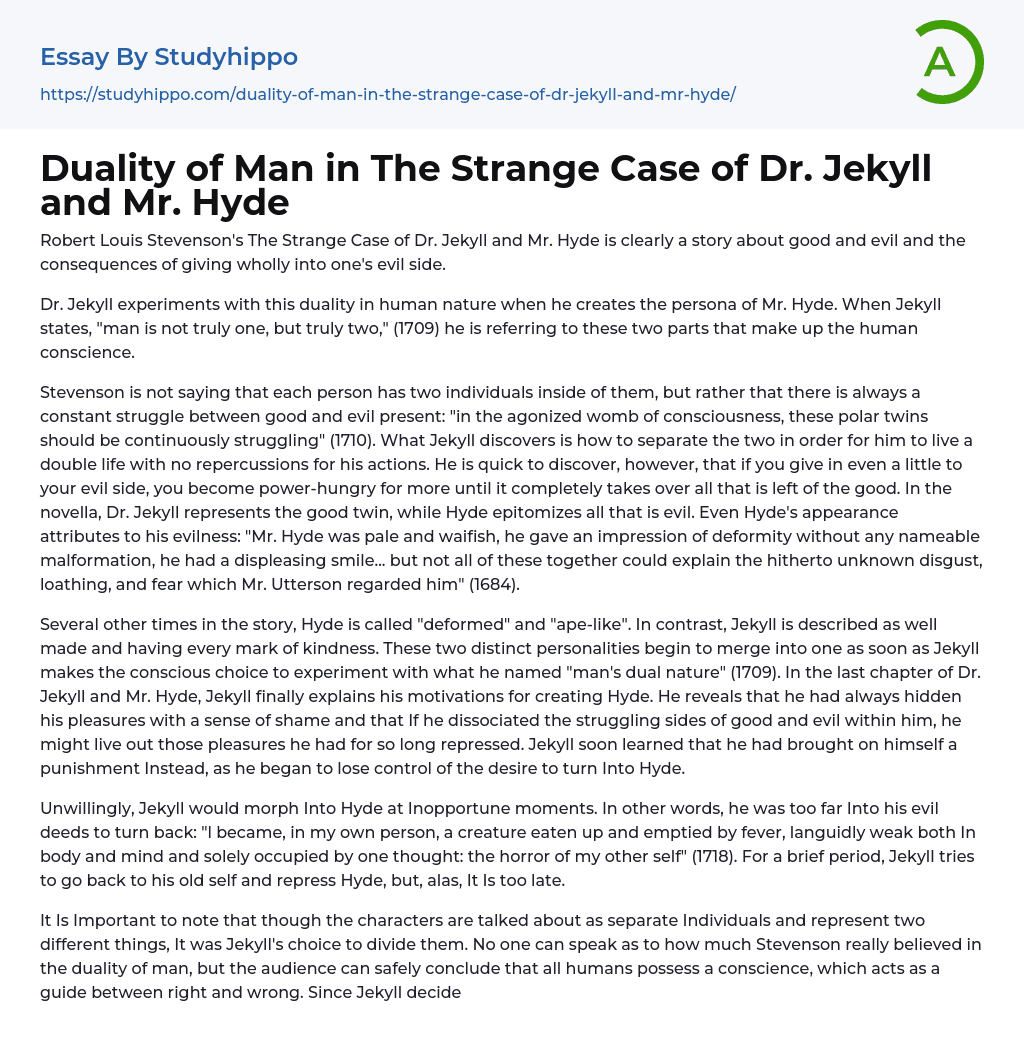

Duality of Man in The Strange Case of Dr. Jekyll and Mr. Hyde Essay Example
Robert Louis Stevenson's The Strange Case of Dr. Jekyll and Mr. Hyde is clearly a story about good and evil and the consequences of giving wholly into one's evil side.
Dr. Jekyll experiments with this duality in human nature when he creates the persona of Mr. Hyde. When Jekyll states, "man is not truly one, but truly two," (1709) he is referring to these two parts that make up the human conscience.
Stevenson is not saying that each person has two individuals inside of them, but rather that there is always a constant struggle between good and evil present: "in the agonized womb of consciousness, these polar twins should be continuously struggling" (1710). What Jekyll discovers is how to separate the two in order for him to live a double life with no repercussions for his actions. He is quick to disc
...over, however, that if you give in even a little to your evil side, you become power-hungry for more until it completely takes over all that is left of the good. In the novella, Dr. Jekyll represents the good twin, while Hyde epitomizes all that is evil. Even Hyde's appearance attributes to his evilness: "Mr. Hyde was pale and waifish, he gave an impression of deformity without any nameable malformation, he had a displeasing smile... but not all of these together could explain the hitherto unknown disgust, loathing, and fear which Mr. Utterson regarded him" (1684).
Several other times in the story, Hyde is called "deformed" and "ape-like". In contrast, Jekyll is described as well made and having every mark of kindness. These two distinct personalities begin to merge into one as soon as Jekyll makes th
conscious choice to experiment with what he named "man's dual nature" (1709). In the last chapter of Dr. Jekyll and Mr. Hyde, Jekyll finally explains his motivations for creating Hyde. He reveals that he had always hidden his pleasures with a sense of shame and that If he dissociated the struggling sides of good and evil within him, he might live out those pleasures he had for so long repressed. Jekyll soon learned that he had brought on himself a punishment Instead, as he began to lose control of the desire to turn Into Hyde.
Unwillingly, Jekyll would morph Into Hyde at Inopportune moments. In other words, he was too far Into his evil deeds to turn back: "l became, in my own person, a creature eaten up and emptied by fever, languidly weak both In body and mind and solely occupied by one thought: the horror of my other self" (1718). For a brief period, Jekyll tries to go back to his old self and repress Hyde, but, alas, It Is too late.
It Is Important to note that though the characters are talked about as separate Individuals and represent two different things, It was Jekyll's choice to divide them. No one can speak as to how much Stevenson really believed in the duality of man, but the audience can safely conclude that all humans possess a conscience, which acts as a guide between right and wrong. Since Jekyll decided to split his conscience and Ignore all the wrong behavior on Hyde's part, he should still be held responsible for his actions, which Is why Stevenson kills him at the end of the novella. Perhaps, himself.
Had Jekyll really chosen to redeem himself, he might have lived.
- Acceptance essays
- Age Of Enlightenment essays
- Child Observation essays
- Confucianism essays
- Conscience essays
- Critical Reflection essays
- Destiny essays
- Determinism essays
- Empiricism essays
- Environmentalism essays
- Epistemology essays
- Ethics essays
- Ethos essays
- Existence essays
- Existentialism essays
- Fate essays
- Free Will essays
- Functionalism essays
- Future essays
- Good And Evil essays
- Human Nature essays
- Individualism essays
- Meaning Of Life essays
- Metaphysics essays
- Natural Law essays
- Personal Philosophy essays
- Philosophers essays
- Philosophy Of Life essays
- Political Philosophy essays
- Pragmatism essays
- Reality essays
- Relativism essays
- Teaching Philosophy essays
- Time essays
- Transcendentalism essays
- Truth essays
- Utilitarianism essays
- Boy essays
- Gay essays
- Gender essays
- Gender Identity essays
- Gender Roles In Society essays
- Gender Stereotypes essays
- Girl essays
- Homosexuality essays
- Human Sexual Behavior essays
- Lgbt essays
- Man essays
- Masculinity essays
- Sexual Orientation essays



